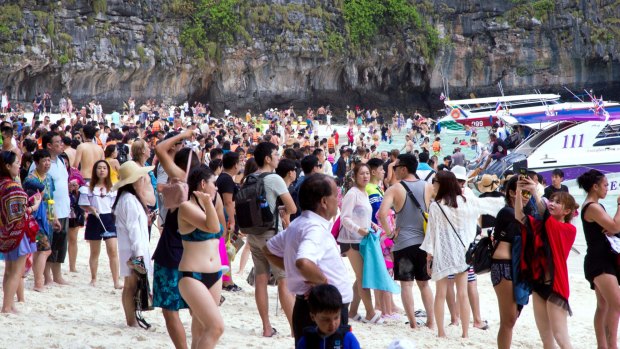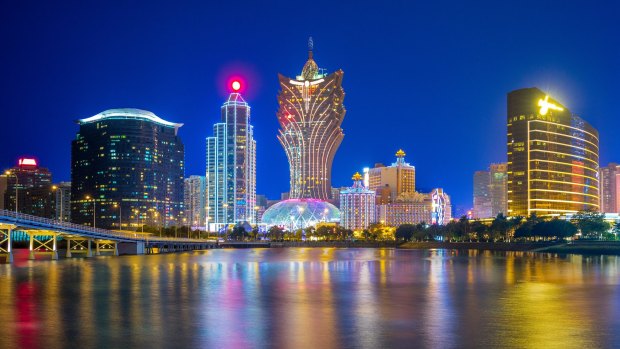This was published 5 years ago
Top countries for Chinese tourists: The impact of China's tourism on the globe

Thailand has become one of the most popular destinations for Chinese tourists.Credit: Shutterstock
In the year 2000, just 10.5 million Chinese travelled overseas. That was less than 1.5 per cent of all international travellers for that year. In 2017 Chinese tourists made 145 million cross-border trips according to the China Outbound Tourism Research Institute.
Today, more than one in every 10 international travellers comes carrying a Chinese passport, and they have deep pockets. Chinese tourists spent $US261 billion in 2016 according to the institute, more than twice as much as US travellers, second on the big-spender ladder.
Impressive as those numbers are, these numbers are just the tip of the Chinese iceberg. Less than 10 per cent of the Chinese population of 1.4 billion owns a passport, and the number of Chinese citizens who travel overseas continues to grow at a faster rate than the total number of global travellers.

Macau receives the most visitors from mainland China. Credit: Shutterstock
The China Outbound Tourism Research Institute predicts that overseas trips by Chinese citizens will increase to more than 400 million by 2030. That would require Chinese outbound tourism to grow by 8 per cent each year which is ahead of trend, but a figure close to 300 million is highly likely.
A significant number of the cross-border trips made by Chinese travellers were to "Greater China" – Hong Kong, Macau or Taiwan. While those destinations alone have accounted for more than half of all Chinese overseas tourism in recent years, the percentage has been dropping since 2015 as Chinese travellers spread their wings to more distant, more exotic and unfamiliar destinations.
And even when you subtract the number of Chinese who visited Greater China destinations, the number of Chinese who travelled into the wider world is still greater than the number of US citizens who travelled beyond their own borders, second on the "most travellers" ladder.
After Hong Kong and Macau, the most popular destination for Chinese travellers in 2017 was Thailand, with almost 10 million visits. This was despite the Thai Government crackdown in late 2016 targeting "zero-dollar" package tours, under which tourists pay for food and accommodation upfront, with much of the payments for travel bookings siphoned off through foreign-national intermediaries. Japan was the next most popular destination for Chinese travellers in 2017, followed by Vietnam and South Korea.
Although it sits well down the league tables – Germany records more Chinese visitors – Australia is benefiting massively from Chinese tourists, with 1.39 million arrivals in the year ended February 28, 2018, a 13 per cent jump from the previous year. That was the first year when China overtook New Zealand as our number one source of international visitors.
In 2017, Chinese visitors also replaced Australians as the number one source of visitors to Indonesia, with Bali by far the main beneficiary of the influx.
Chinese tourists are contributing to the tsunami of world tourism that is overwhelming some European cities such as Barcelona and Venice, however their travel patterns differ in some significant areas from those of Australians, Europeans and North Americans.
Many travel overseas in the major Chinese holiday periods of early May and October and around the lunar new year, months when Europeans and North Americans are more likely to stay home. They often travel to places that others are unlikely to visit, such as the city of Trier in Germany's Moselle region, birthplace of Karl Marx. They also tend to travel quickly. Even in culturally rich destinations such as London, Rome and Paris, two-night stays are not uncommon.
According to the United Nations World Tourism Organisation, Chinese tourists account for more than a fifth of the money spent by international travellers. Every Chinese visitor spends about twice as much per day as the average non-Chinese tourist, which is part of the reason that every national tourism office is doubling down on its efforts to attract them.
However regrettable some of the aspects of mass tourism might be, there are plenty of reasons to welcome the phenomenon, even apart from the flood of dollars and employment opportunities it creates.
Chinese tourism is helping drive the spread of China-based airlines. Australia is currently serviced by seven China-based airlines, and that level of competition is keeping the price of international flights at an all-time low in real terms, as well as offering easier access to new cities within China and Asia.
A bigger tourism industry is good for innovation. It encourages tourism operators to diversify. As the number of tourists increases so too do the possibilities. Hotels and tour operators are encouraged to think differently and develop niche products that will appeal to specific tastes.
The top 10 destinations for Chinese tourists
- Hong Kong
- Macau
- Taiwan
- Thailand
- Japan
- Vietnam
- South Korea
- Singapore
- USA
- Italy
Sign up for the Traveller Deals newsletter
Get exclusive travel deals delivered straight to your inbox. Sign up now.